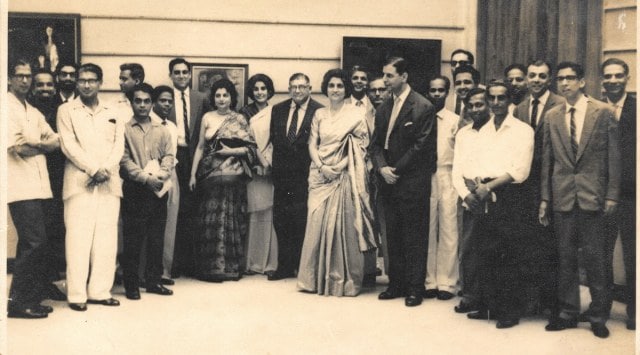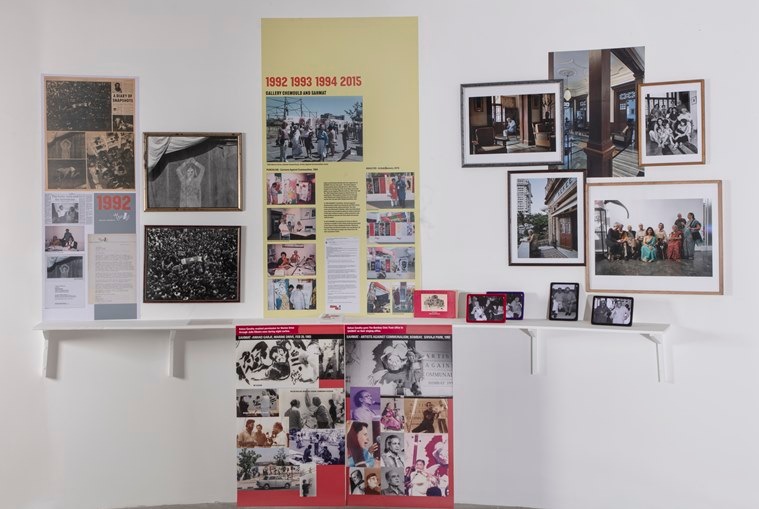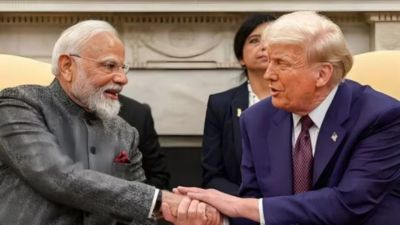📣 For more lifestyle news, click here to join our WhatsApp Channel and also follow us on Instagram
How a framing company became Mumbai’s iconic Gallery Chemould
From framing MF Hussain and FN Souza’s paintings to showcasing them, here’s how Kekoo Gandhy laid the foundation for Chemould which turns 60 on Saturday
 Opening of Gallery Chemould 16 Sept -1963 - LtoR, K.K Hebber, Laxman Pai, Gal Arya (Architect), Siaxes Chandan & Gaitonde, other members of the family and staff. (Credit: Chemould Archives)
Opening of Gallery Chemould 16 Sept -1963 - LtoR, K.K Hebber, Laxman Pai, Gal Arya (Architect), Siaxes Chandan & Gaitonde, other members of the family and staff. (Credit: Chemould Archives)Year 1940. As World War II raged, Mumbai-based 20-year-old Kekoo Gandhy was unable to return to Cambridge where he was studying economics. QOne day, a car broke down in Juhu and he lent a helping hand to the driver – a Belgian businessman. A conversation here led to a partnership between the two which paved the way for Mumbai’s Chemical Moulding Manufacturing Company — later abbreviated to Chemould — that manufactured frames for paintings.
One of the early establishments to offer painting frames, the shop – Chemould Frames on Princess Street – attracted MF Hussain, FN Souza and their peers from Progressive Artists’ Group to get their paintings framed, and in the process develop a friendship with Kekoo and turn his born-out-of-a-godown shop into an art salon. But the artists had nowhere to take these paintings so they were put on display at Kekoo’s shop, which sowed the seed in his head for creating a market for artists and their artwork.
On Saturday, Chemould Prescott Road — which opened as Gallery Chemould on the first floor of Jehangir Art Gallery in September 1963 — one of the oldest art galleries in Mumbai turns 60.
“He would take these paintings to Rotary clubs or pursue philanthropists and industrialists to host an exhibition or buy the works. That’s how he started creating patronage,” shares independent art consultant and curator Shaleen Wadhwana. “Today one would kill for a Hussain but in those days, these paintings were being sold under Rs 500,” adds Wadhwana.
 Photographer Ram Rahman has looked at Gallery Chemould’s relationship with Delhi’s Safdar Hashmi Memorial Trust (SAHMAT). (Photo courtesy: Chemould)
Photographer Ram Rahman has looked at Gallery Chemould’s relationship with Delhi’s Safdar Hashmi Memorial Trust (SAHMAT). (Photo courtesy: Chemould)
Kekoo’s daughter Shireen, the current director of Chemould Prescott Road, points out that it wasn’t a business. “It was a new-found love,” says Shireen, who took over the reins of the gallery from her parents in 1988. “Initially, it was about the vanity of frames looking good on these paintings until the reverse happened and the paintings took centre stage.”
The business, however, was still framing. But because he was busy promoting art, it was getting ignored. “According to the manager of Chemould Frames, a lot of his (Kekoo) time was being ‘wasted’,” says Shireen, adding that he returned to art in the early ’60s when Parsi industrialist Sir Cowasji Jehangir proposed that he take over the first floor of the building to start his gallery.
The space had no flooring or ventilation but a projector room. “They had to completely rebuild the floor for which they got architect Jal Arya on board. He was very innovative, artsy, and well-tuned but he took forever to complete the job,” says Shireen. Kekoo would often say to his children, ‘You see my grey hair, that’s because of Jal Arya’.
In May 1963, Kali Pundole opened Pundole Art Gallery. Gallery Chemould opened in September 1963. “My father carried that grudge forever and blamed his architect for the delay,” says Shireen.
 Khorshed, Shireen and Kekoo Gandhy[L-R], 2003, 40th Anniversary Exhibition (Image Credit: Chemould Archives)With the gallery, Shireen’s mother Khorshed, who was until now busy tending to home and children, came to the forefront. Someone who had an acute sense of business, Khorshed was very efficient with the accounts. “She would do mental calculations in Gujarati and be very good with handling money,” shares Shireen, recalling how she always had envelopes with money being segregated for various purposes.
Khorshed, Shireen and Kekoo Gandhy[L-R], 2003, 40th Anniversary Exhibition (Image Credit: Chemould Archives)With the gallery, Shireen’s mother Khorshed, who was until now busy tending to home and children, came to the forefront. Someone who had an acute sense of business, Khorshed was very efficient with the accounts. “She would do mental calculations in Gujarati and be very good with handling money,” shares Shireen, recalling how she always had envelopes with money being segregated for various purposes.
As for Kekoo, he knew how to get people’s attention and wanted people to genuinely care about art. Wadhwana adds that her research — which includes going through 15,000 archival items, including letters, awards, invitation cards, albums, press clippings, photographs, telegrams, and documentation — throws up how on vacations, he would visit every gallery, asking them if they could show Indian artists. “In fact, he managed to impress Farah Pahlavi, former queen, and empress of Iran and we had an artist’s art exchange with them in the 1970s and when she travelled to India, she visited Chemould,” says Wadhwana.
Prior to this, in 1968, Chemould saw Pope Paul VI from the Vatican City because Kekoo put together a huge exhibition asking the progressive artist to respond to the theme of Christ, responding to the movement seen in Europe
The gallery was also active in the socio-political space. Both Kekoo and Khorshed were very engaged with the politics of the time. Shireen was sent to Amethi during the general elections of 1989. “We didn’t have an exhibition at that time because we were preoccupied with getting Mahatma Gandhi’s grandson Rajmohan Gandhi elected from Amethi,” says Shireen.
During the emergency, artist Anjali Menon, a rising star then, wanted to do a show but she was turned down because “who wants to show art when freedom is being curtailed”.
 The Progressive Artists Group, 1940s, surrounded by their supporters at the Bombay Art Salon. (ImageCredit: Chemould Archives)
The Progressive Artists Group, 1940s, surrounded by their supporters at the Bombay Art Salon. (ImageCredit: Chemould Archives)
Whether it was showing MF Hussain’s art installations when paintings were all he was known for or political cartoons by Mickey Patel in 2002 or abstract, colourless, almost white-on-white paintings by Homi Patel, Shireen says there were “many acts of bravery”.
As a child, Shireen would hover in the gallery and developed a particular liking towards artist SH Raza and his wife Janine when they moved to the second floor of their building. Shireen decided to pursue art administration years later. Taking the legacy forward is the third generation — her daughter Atyaan Jungalwala, who started Chemould CoLab in 2022, a space that nurtures younger artists and exhibits their work.
To mark the 60 years of Chemould, the art gallery will have four shows spread through the coming months and across three venues, including Jehangir Art Gallery and CoLab. Inaugurating the festivities is CheMoulding Framing Future Archives, a two-part exhibition taking place at Chemould Prescott Road that has been curated by Wadhwana. The first part, which is available for viewing till October 28, ‘Framing’ recognises the frame moulding company as the genesis of this gallery and will see 19 artists responding to archival history, while ‘Futuring’ will see 15 artists telling us where we are going in terms of emotion, society, and self.
“Jitish Kallat is making an architectural intervention as he creates a footprint of the old gallery – Gallery Chemould – in the new gallery, Chemould Prescott Road,” says Wadhwana. There is also a room for dissent dedicated to artists who have looked at resistance and resilience. Here photographer Ram Rahman has looked at Gallery Chemould’s relationship with Delhi’s Safdar Hashmi Memorial Trust (SAHMAT) and how it served as its unofficial office in Mumbai. Completing the circle is the artwork by Gigi Scaria featuring a series of frames.
📣 For more lifestyle news, follow us on Instagram | Twitter | Facebook and don’t miss out on the latest updates!
📣 For more lifestyle news, click here to join our WhatsApp Channel and also follow us on Instagram





- 01
- 02
- 03
- 04
- 05






















